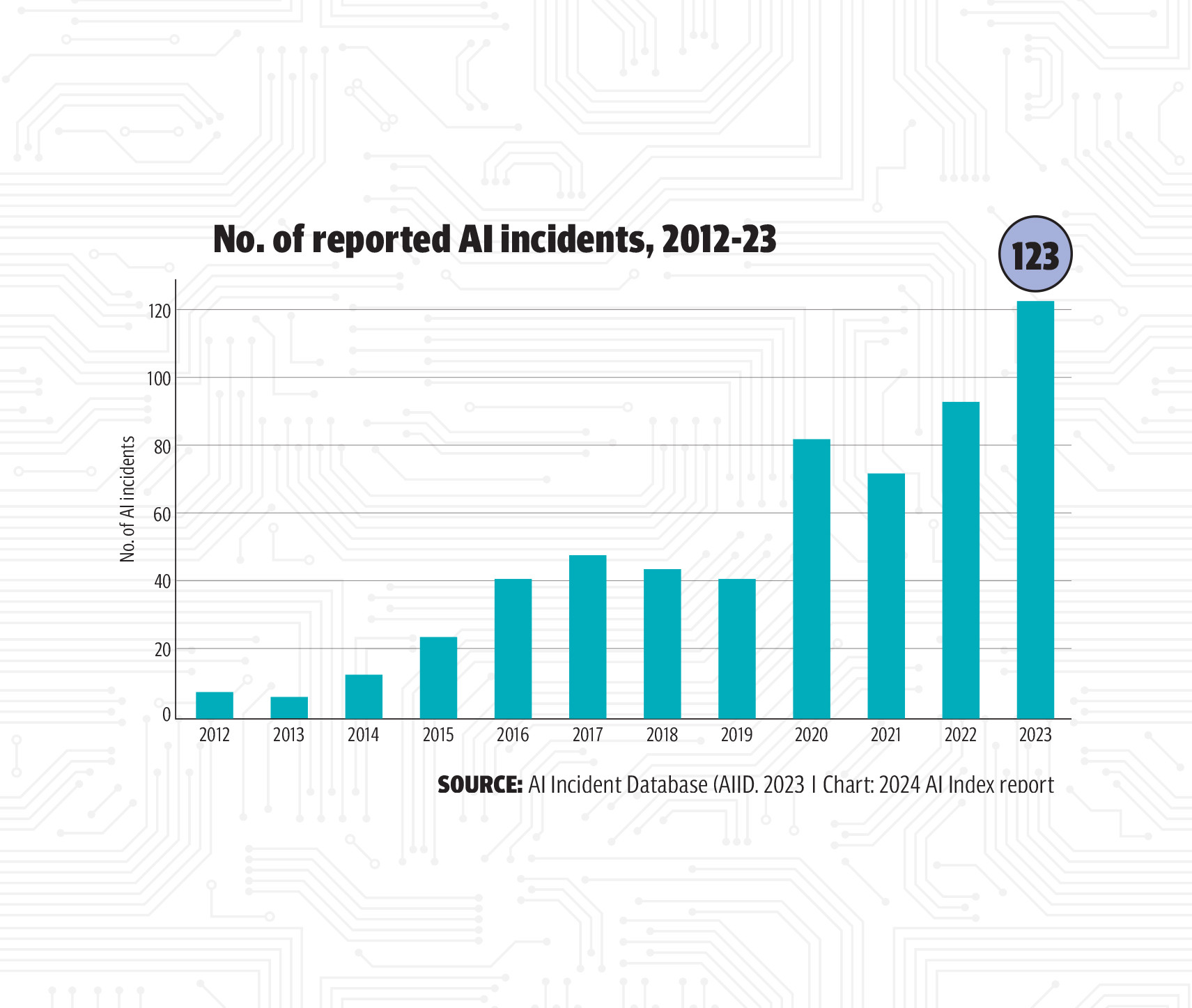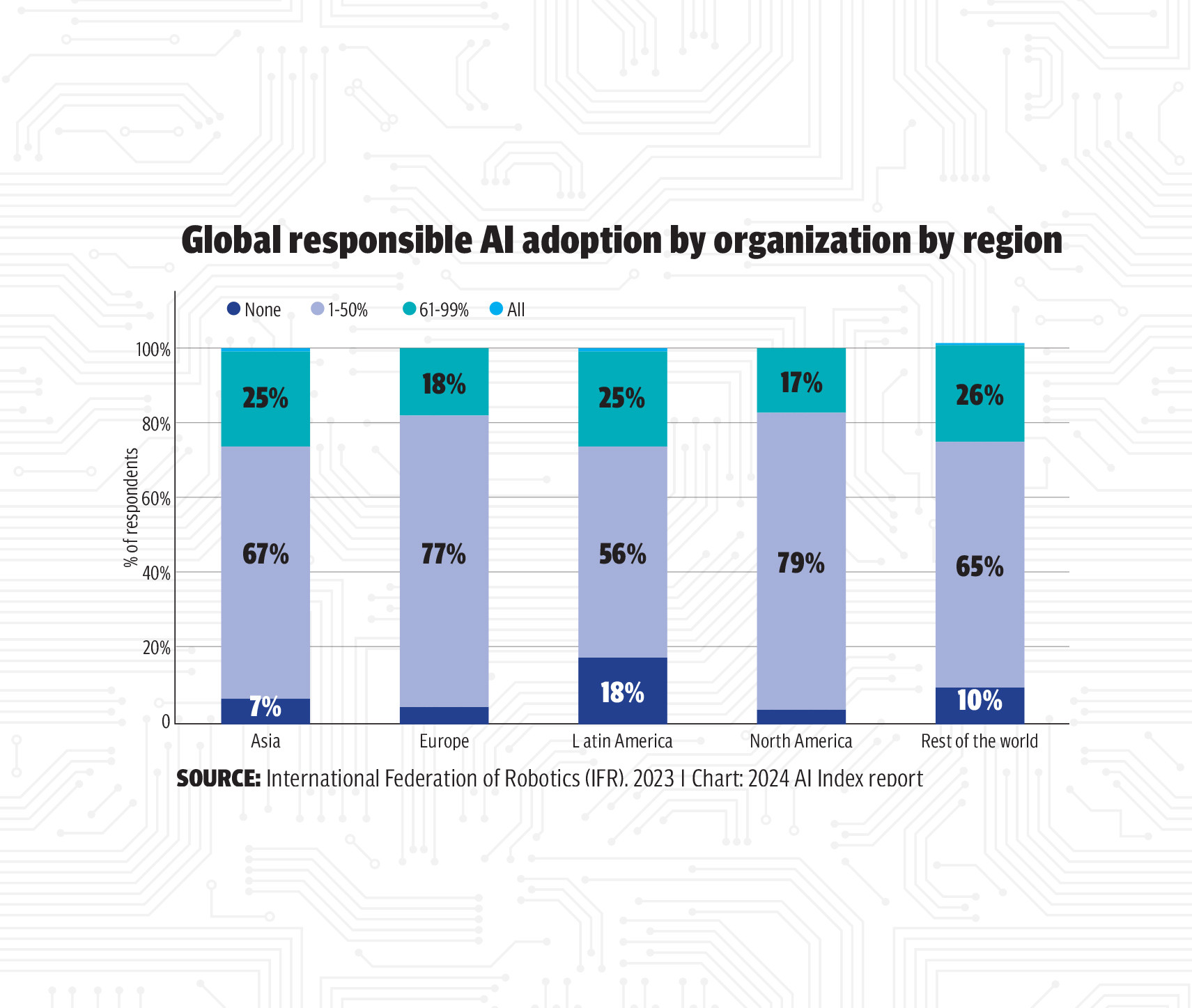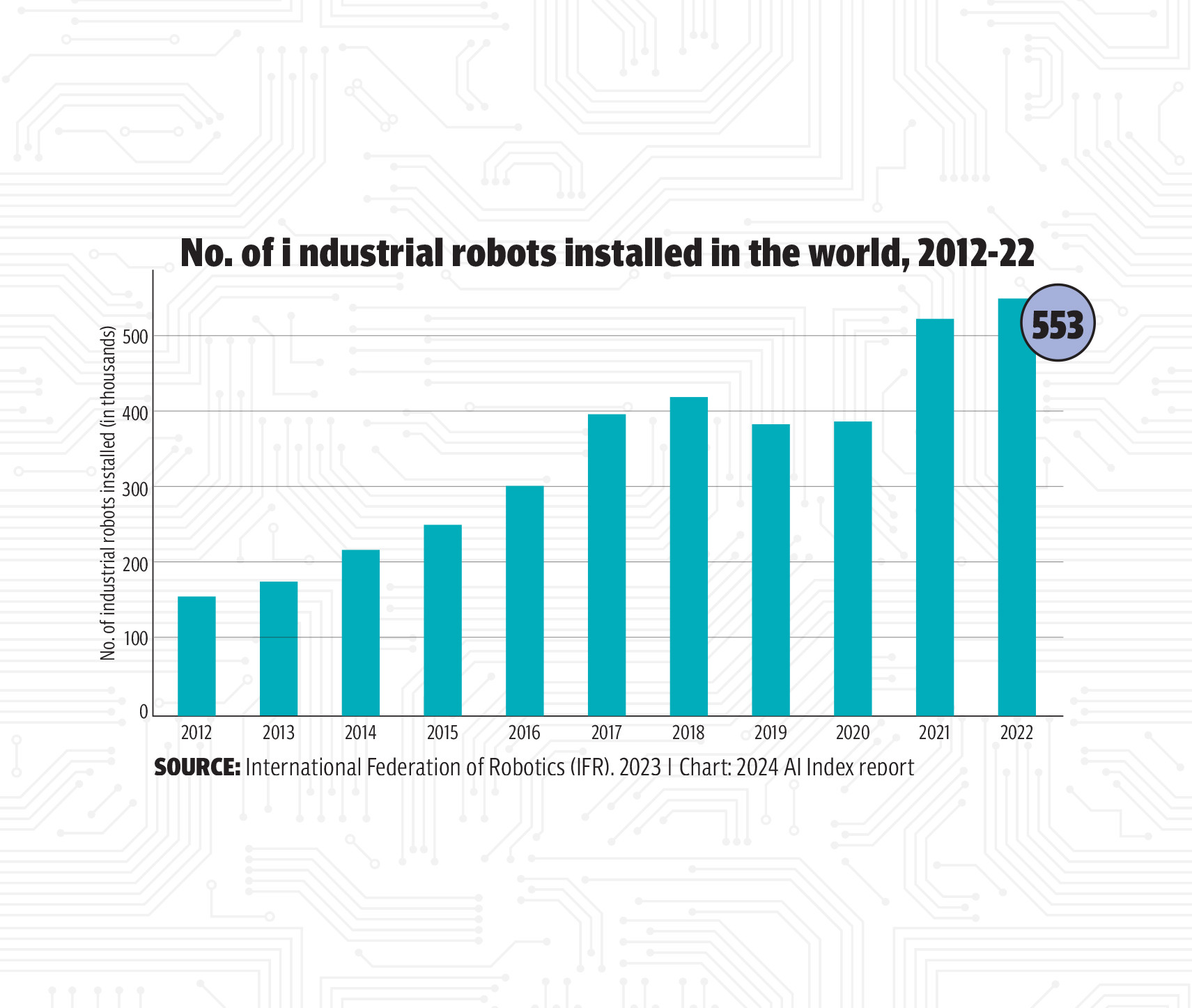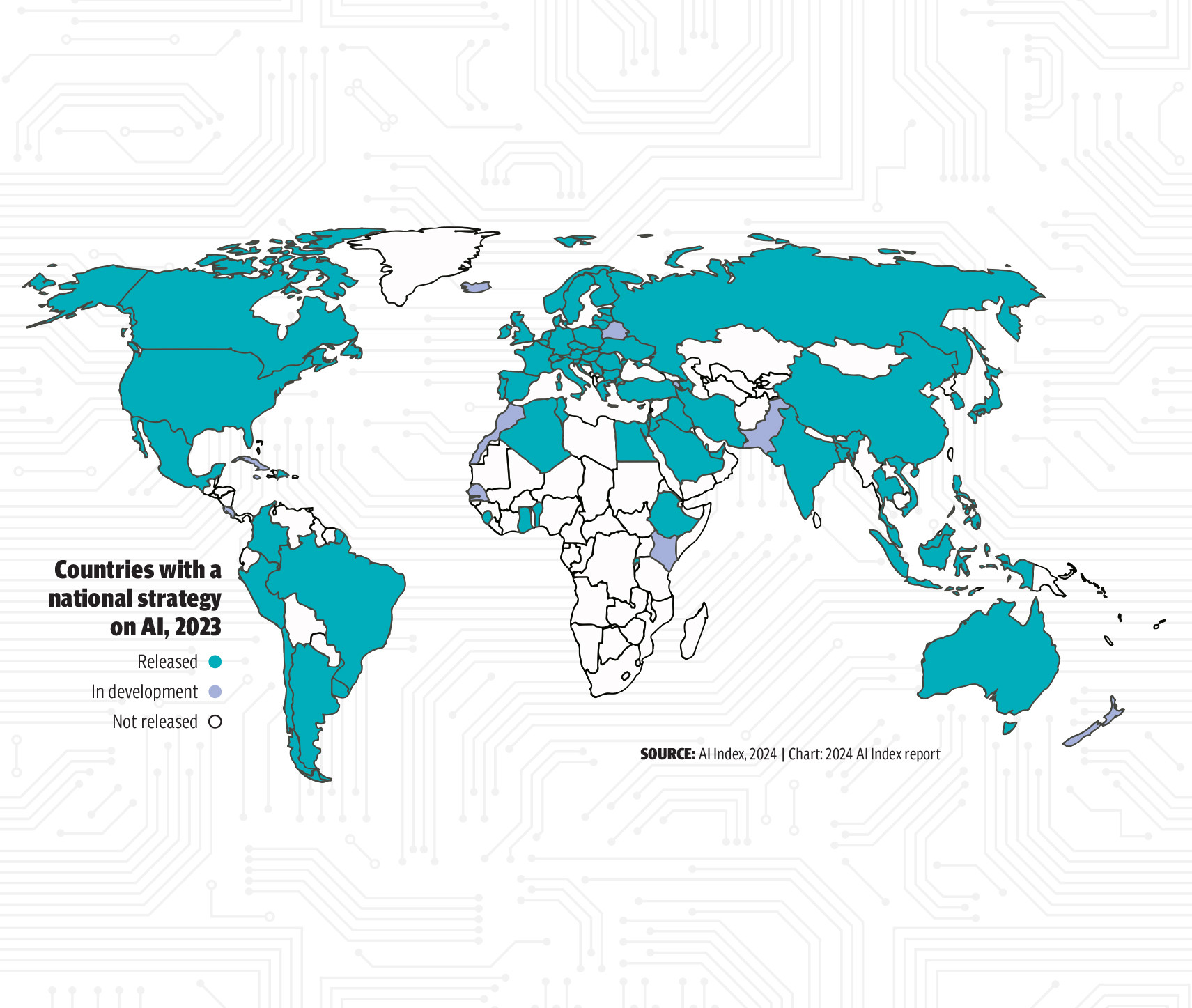It’s no longer science fiction. It’s no longer the figment of a mad scientist’s imagination. It’s a reality – an unbelievable scientific reality. You guessed right! I’m talking about artificial intelligence. AI is the most transformative and, at the same time, the most disruptive technology of this century. Transformative, because it is radically changing the way we work, the way we think, and the way we live; and disruptive, because it is disrupting almost everything we humans have developed over the past five decades. “The rise of AI is as big a development as the industrial revolution, as the combustion engine, and as the printing press,” says Ozzier Khan, Director, Digital Innovation and Architecture at the Asian Development Bank’s Information Technology Department.
What exactly is AI? It is the ability of a machine (computer system) to think, learn, innovate, and thereby master many tasks that were once exclusive to humans. Generative AI is increasingly used by organisations for different purposes, including for optimising efficiency, rationalising costs, and assisting in human decision-making.
“Anyone working 9am to 5pm on a laptop will see his work disrupted. I mean everything we have developed during the last 50 years on the professions side, especially the white-collar jobs, will get disrupted,” says Khan. “However, blue-collar jobs, I mean the hand-on jobs that involve manual labour, may not be disrupted, at least at this stage.”
AI is shaping the future of humanity by automating and optimising services in almost every industry, be that healthcare, retail, education, finance, media and entertainment, logistics, manufacturing, and hospitality. Businesses are increasingly harnessing the AI potential. According to a 2023 IBM survey, 42% of enterprise-scale businesses in the US have integrated AI into their operations, and 40% are considering this technology for their organisations. Moreover, 38% of organisations have implemented generative AI into their workflows while 42% are considering doing so.
Some industries may have taken the lead, but the bewildering advancement of AI shows its application has limitless possibilities and it could be effectively used to find solutions to some of the most complex problems of our times.

For climate mitigation
Climate change is becoming an existential threat to humanity as adverse climatic events are increasing both in frequency and intensity, exacting a toll in lives and treasure, and triggering mass migrations worldwide. Cooling down our planet or at least slowing down the rate of global warming is a collective fight for which every available resource needs to be utilised. In 2022, a flood of biblical proportions killed and injured thousands, and displaced millions in Pakistan and inflicted a financial cost of nearly $20 billion. There would be approximately 40 million climate-induced migrants in South Asia alone by 2050, according to the World Bank’s Groundswell report.
AI can offer both prescriptive and preemptive solutions to the climate change issues. “With the technologies we have, we can only predict the next hurricane or even maybe give some early warning, right? But with AI, we can feed all the data we have in a model and it will not only predict when the next flood may or may not happen, but it may also give you prescriptive scenarios for health, education, and many other sectors that the flood will impact,” says Khan.
In this context, Khan cites the example of “Cooling Singapore 2.0”, a multidisciplinary project that seeks to transform Singapore into a climate resilient and regenerative city-state. “It aims to improve the livability of the city-state, considering that it is increasingly becoming warmer due to the urban heat island effect,” says Khan. “Simulations are being run to determine what variations of strategies will best reduce heat and improve the city’s resilience to climate change.”
Having said that, it seems paradoxical to enlist AI in our arsenal to fight climate change. AI relies on huge amounts of data, and to maintain that data we have to have data centres. These data centres, which work 24/7, require huge amounts of energy to operate. According to one study, the data centres and cloud services we presently have contribute 2.5 to 3.7% of global carbon emission, exceeding emissions from commercial flights.
“No doubt, there is a cost, the carbon cost. But you have to weigh it against the value that you’re getting from AI versus what you’re getting from other industries. This is going to change the way many of the industries currently operate,” says Khan. “The encouraging thing, however, is that the three big market players, AWS, Google and Microsoft that own about 90% of the data centres worldwide, are committing to a shift to renewable energy. They’re all committing to be compliant with mutually agreed upon parameters.”

In education
Tech experts believe AI has the potential to help us surmount some of the biggest challenges in the education sector by innovating teaching and learning practices. Although it might be too early to conclude how AI models could be integrated into the education sector, key uses of AI technologies in education may include adaptive learning platforms, automated grading and feedback systems, chatbots for student support, intelligent tutoring systems, and AI-powered educational games.
This could bring a paradigm shift in the traditional education methods. “In the world of AI, the education we need is different. Until now we have been teaching our students how to answer questions, but now you don’t need to know the answer. You need to know the question. Therefore, our curriculum has to change. In the US, for example, today if you go to any top school, they are changing their curriculum, changing the way they teach, introducing different ways of teaching,” says Khan. “We need to do the same in Pakistan,” he adds while noting that Aga Khan University Hospital is already blazing a trail.
The 2020 outbreak of novel coronavirus pandemic prompted a shift towards virtual learning, which, if sustained systemically, can benefit a much wider population. UNESCO says it is committed to supporting nations to harness the AI potential for achieving the “Education 2030 Agenda” that aims to address inequalities in access to knowledge, research, and cultural expressions. The importance of AI in education is sinking in quicker than initially expected. In 2022, there were 30 multimillion-dollar AI-in-education corporations, and analysts predict AI in the education market to be worth over $20 billion in five years.
“One of the most significant contributions of AI to education is the facility to design learning experiences for every student based on their individual abilities and learning styles,” writes data science enthusiast Dr Praveen Kumar Loharkar in a recent article in The Hindustan Times. “The AI-powered educational platforms detect the student's learning style, features and problems, and thus create a logical progression with which the student can engage.”
Kumar believes that AI can not only enrich the students learning process but can also promote the teachers' professional growth. AI technologies can appraise teacher performance, give feedback, and recommend specific learning materials that are customised to every individual, thus making them learn new techniques.

In media
The media and entertainment have always been early adopters of new technologies, embracing the digital revolution and taping the potential of the ever-evolving technology to create better content and enhance user experience. AI offers the media an array of tools for content personalisation, use of artificial reality and virtual reality, targeted advertising, improved streaming quality, controlling the distribution of online content, predictive analysis, and content categorisation.
Global leaders in the print media like The New York Times and The Washington Post have started creating AI columns. “My own news is AI-generated. There’s a lab that curates news and then sends it to me. So, the AI-generated news is news,” Khan says. “In my personal opinion, one day The New York Times might be 70% AI, but for that to happen they will have to put in place rigorous safety, fairness, and transparency checks.”
However, AI’s media embrace has also triggered widespread fears of plagiarism, and copyright and intellectual property right infringement. “As a writer you’re inspired by so many things. When you write, there’s a bit of what you have read in the past, what you’ve grown up with, right? That all goes into your creation, in your writing, I mean. AI is somewhat similar. It will take a bit of the past and create something new,” says Khan.
Nonetheless, you cannot expect “brand new thinking” from a machine. It cannot be a substitute for the human mind. You teach it, it learns, interprets, innovates, and generates something new for you. “At the end of the day it is artificial intelligence. And it will remain artificial,” says Khan before adding that the only way humans would have an edge in the knowledge economy is through creativity.

Development inequalities
AI’s spectacular but uneven and unregulated development also raises a lot of ethical questions. Fears run rampant that this revolutionary technology would make global inequality in development more jarring. Since AI models rely on big data, developed countries would have a monopoly over data because poor and developing countries neither have data nor data storage capacities. But Khan doesn’t agree. “Today, we all are at the starting point. Early investment is the key. And I’m not talking about investment of billions of dollars,” he says. “At the basic level, it’s not the matter of cost, but of willingness, awareness, and understanding, of having that mindset to invest in AI.”
Khan believes not investing in AI now would make inequality in development more pronounced. “It is easily doable at this stage provided there is a will,” he says. “You have seen ChatGPT, Gemini, and Perplexity. To me, they're like the beginning of Internet. It's like the Cisco pipeline wiring,” Khan says. “The wiring is kind of shaping. The change will now begin to happen. And since the change will happen, everyone, the US, Pakistan, or any other country, is at the starting line. No one is ahead. No one can say this AI company is going to change the world,” he adds. “That will happen in the next decade – or maybe a decade and a half.”

According to Khan, now is the time for Pakistan to start serious efforts to tap into the AI potential, otherwise it would even lag behind its immediate neighbours. “India has embraced AI. And I believe India is going to be a major player in future. They’re not only going to consume AI, but they are also on the production side,” he says. “Bengaluru is very close to the West.”
Bengaluru has become the “Silicon Valley of India” as it is attracting workers and regional headquarters of some of the world’s biggest IT companies, including Google, Microsoft, Cisco, Intel, IBM, and Accenture. And this is the secret behind the spectacular growth of India’s exports of computer software and services, which grew 12.2% in 2022-23 to $193 billion. Pakistan’s technology exports, on the other hand, were a meager $2 billion during the same time period.
The Indians know that they can harness the AI potential in a big way. “Before the end of this decade, more Indians will use AI every day than in any other country in the world. What’s more, people in advanced economies will be surprised by the ways the country will use AI,” write Nandan Nilekani, the chairman and cofounder of Infosys; and Tanuj Bhojwani, head of People+AI, in an article titled ‘Unlocking India’s potential with AI’ published on IMF website. “India is on the cusp of a technological revolution that could alter the trajectory of its social and economic future, and in this revolution there are lessons for the rest of the world.”
Khan says that to be part of AI economy it is important for all developing economies to integrate AI literacy into their education systems, invest in AI research, and introduce policies and regulations that promote AI development and deployment.

Challenges for Pakistan
According to a report by Bloomberg Intelligence (BI), with the influx of consumer generative AI programs like Google’s Bard and OpenAI’s ChatGPT, the generative AI market is poised to explode, growing to $1.3 trillion over the next 10 years from just $40 billion in 2022. “Big numbers! So, countries like Pakistan have an opportunity to get a slice in the pie. And that's what we are saying. If you look at investments, where they are going now: AI,” Khan says.
Countries around the world are stepping up their game realising that AI is the future. Take, for example, Singapore which is spending up to S$500 million on graphics processing units (GPUs) which are crucial for developing AI apps, to ensure that local enterprises can access tomorrow’s high-performance computing infrastructure. The spending is about half of the S$1 billion-plus investment for Singapore’s National AI Strategy 2.0 unveiled in December 2023. This investment in AI compute infrastructure is one of five AI initiatives in the Singapore roadmap for 2024. “The Singapore government has just bought huge capacity in processing GPUs that they don't even use right now. They're hoarding it,” says Khan. “Now in Pakistan, where there are challenges, is the government making such AI investments?”
Khan says there are some fundamental challenges that Pakistan has to tackle. No. 1 among them is data, or access to data. “We don’t have a data storage capacity. But we are not alone, Bangladesh, Sri Lanka, and a lot of other countries are facing the same challenge,” says Khan. “The way out is building partnerships to create government sovereign cloud because the countries that are moving forward are the ones that are creating partnerships to allow this data to fuel AI growth.”
No doubt most developing economies face financial constraints to invest in new technologies, but they can collaborate with partners, such as the private sector and multilateral development banks, to help bridge the funding gaps, says Khan.

Downside and risk
Like all other technologies, AI also has a downside to it. It has risks. It has a huge potential for misuse. It’s prone to biases. It creates data security and data sovereignty concerns, leading to fears that AI could transform our world into George Orwell’s dystopian society in ‘1984’ where Big Brother [read: Big Tech] is surveilling us all the time. Nonetheless, not embracing AI is not an option because its advantages heavily outweigh the potential risks involved. So, what is the way out?
“We need to have a balanced approach to begin with. We need to use AI responsibly. And in order to ensure a responsible use of AI, we have to have frameworks and governance in place,” says Khan. “There are risks. There will be risks. Like with cars, right? They didn’t have seat belts in the beginning. It took them some time to realise the need for seat belts. Similarly, we might have missed security protocols as AI is still in its infancy. However, I’m optimistic because I’m seeing it firsthand, working with it on a daily basis,” says Khan.
According to him, governments can take all stakeholders into confidence to put in place regulations and strategies for a responsible use of AI. “You need to have AI regulation. You also need to have an AI international framework and strategy. Without that, you miss out on both: the opportunity and safety of your people,” he adds. “Governments need to take the lead in setting up regulatory frameworks and guidance to ensure that these cutting-edge technologies are ethical.”
